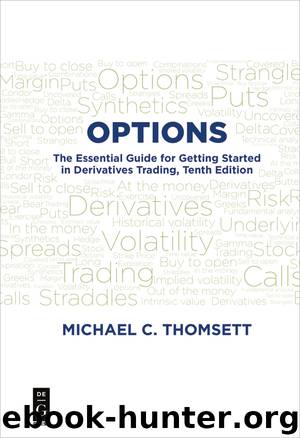Options by Michael C Thomsett

Author:Michael C Thomsett
Language: eng
Format: epub
Publisher: De Gruyter
Published: 2018-10-26T16:00:00+00:00
Historical Volatility
The use of historical volatility to define risk is based on analysis of the underlying. This is sensible because option value is derived from historical volatility. This explains why options are also called derivatives. By analyzing current volatility in the underlying, judgment can be imposed to decide whether the current option premium is overpriced or underpriced. When volatility is high, the option will be overpriced, and vice versa.
A buyer has the best pricing opportunity when volatility is low. Considering that the trend in volatility is cyclical, low volatility tends to trend to high volatility, and high trends back to low. The study of historical volatility is an excellent timing device. A correlation is also found in fundamental volatility (the tendency in financial trends to be consistent, thus low volatility; or unpredictable, thus high volatility). The relationship between fundamental volatility and historical volatility of the underlying security often is consistent, giving the trader additional intelligence about (a) stocks to buy or sell for long-term portfolio building; (b) options trading based on combinations of options and stock positions; and (c) control and hedging of market risk in the equity position.
Historical volatility is based on closing prices each day. It involves calculating daily price changes, finding the standard deviation (in an Excel spreadsheet, the shortcut STDEV can be used to simplify this process. This is next annualized based on an average of 252 trading days per year, and then finding the square root. In Excel, the shortcut is SQRT(252). Despite the convenience of spreadsheet shortcuts, the calculation is not necessary. To determine the timing of options trades, a visual representation of historical volatility is easily observed by overlaying Bollinger Bands on the stock chart.
Referring to the previously introduced stock charts, the high volatility seen on the chart of Alibaba (BABA) is overlaid with Bollinger Bands in Figure 11.3.
Figure 11.3: High Volatility and Bollinger Bands The degree of historical volatility is represented by the distance between the upper and lower bands of this indicator. The middle band (dotted line) represents a 20-day simple moving average. Each of the outlying bands are two standard deviations removed from the center band. Accordingly, the distance between middle band and each of the other two is always identical. As the bandwidth expands, it reveals increasing historical volatility. As price gaps higher or lower, the bands also grow farther apart.
Key Point: The Bollinger Bands indicator is an exceptional tool for visualizing current levels of historical volatility.
The same observation is made for charts showing low volatility. The chart of Caterpillar (CAT) is shown once again in Figure 11.4, this time with Bollinger Bands included.
Figure 11.4: Low Volatility and Bollinger Bands The easily observed price volatility is accompanied by a very narrow bandwidth in Bollinger Bands. This indicator provides another value to the chartist. Traditional explanations of resistance (highest price in the range) and support (lowest price in the range) are represented by straight lines. The use of Bollinger Bands makes tracking resistance and support more flexible. During periods of
Download
This site does not store any files on its server. We only index and link to content provided by other sites. Please contact the content providers to delete copyright contents if any and email us, we'll remove relevant links or contents immediately.
Rich Dad Poor Dad by Robert T. Kiyosaki(6174)
Pioneering Portfolio Management by David F. Swensen(6078)
How To Win Friends and Influence People by Dale Carnegie(4332)
The Money Culture by Michael Lewis(3846)
The Dhandho Investor by Mohnish Pabrai(3560)
The Wisdom of Finance by Mihir Desai(3523)
Liar's Poker by Michael Lewis(3220)
The Intelligent Investor by Benjamin Graham Jason Zweig(2930)
The ONE Thing by Gary Keller(2918)
Mastering Bitcoin: Programming the Open Blockchain by Andreas M. Antonopoulos(2891)
Fooled by Randomness: The Hidden Role of Chance in Life and in the Markets by Nassim Nicholas Taleb(2860)
Rich Dad Poor Dad: What The Rich Teach Their Kids About Money - That The Poor And Middle Class Do Not! by Robert T. Kiyosaki(2834)
Investing For Dummies by Eric Tyson(2793)
How to Win Friends and Influence People by Dale Carnegie(2793)
How to Day Trade for a Living: Tools, Tactics, Money Management, Discipline and Trading Psychology by Andrew Aziz(2785)
Market Wizards by Jack D. Schwager(2538)
Zero Hour by Harry S. Dent Jr. & Andrew Pancholi(2532)
How to Pay Zero Taxes, 2018 by Jeff A. Schnepper(2498)
Rich Dad's Guide to Investing by Robert T. Kiyosaki(2410)
